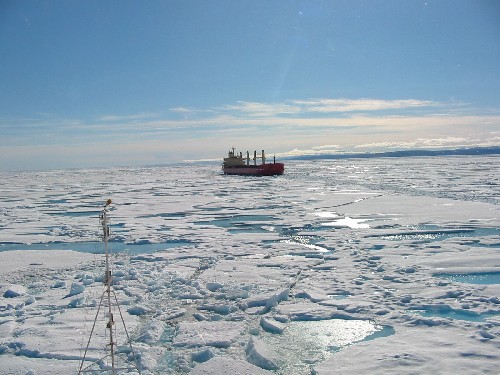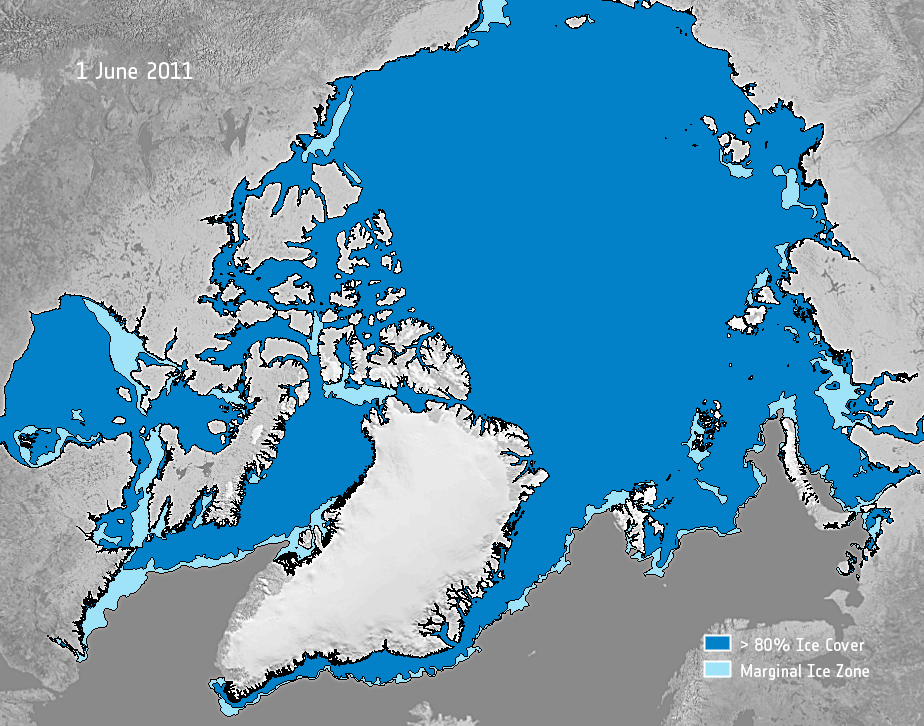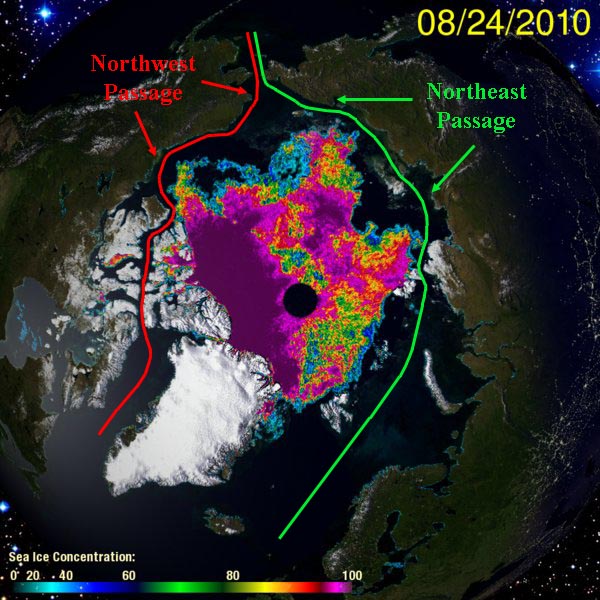The race is on. The European Space Agency (ESA) reports that the Arctic is into another year of below-average sea ice cover, and that the big melt has opened two major shipping routes. After five centuries of imperial intrigue, papal declarations, naval battles, failed commercial ventures, and rueful ends to frostbitten voyages, the elusive Northwest passage appears to be open as a regular summer feature.
An open passage through the frozen Canadian Arctic appeared in summer 2008, for the first time in probably at least 6000 years, and has opened each summer since. ESA recently released this animation showing the time course of ice melt on the frontier in 2011:
The dark blue stuff in the animation is solid ice, the gray is navigable open water. So who cares?
Ever since the illustrious mariner John Cabot (aka Giovanni Caboto, or Jean Cabot, or any of the several other names by which he was known back in the pre-internet days of post-plague Europe) set sail under patronage of Henry VII in 1497 to find a passage to the Orient, and thereby become fabulously wealthy, empires and commercial interests have been chomping at the bit to find a way to to the rich trading opportunities of the Far East that avoids the long slog east through the Indian Ocean or west and south around the tempestuous Cape Horn.
It appears that their ship, as it were, has now come in. According to ESA:
“While the Northern Sea Route above Russia (also known as the Northeast Passage) has been open to shipping traffic since mid-August, recent satellite data show that the most direct course in the Northwest Passage now appears to be navigable as well.
Located in the Canadian Arctic Archipelago, the Northwest Passage can be a short cut for shipping between Europe and Asia – but with the opening of the sea route comes the potential for both sovereignty claims and marine species migration across the Arctic Ocean.”
Sovereignty claims indeed. This is the fourth year in a row that the NW Passage has been clear, after opening for the first time in recorded history in 2008. As the evidence for a warming globe began to mount over the last couple decades, the prospect of an open Arctic Ocean has been fueling tensions and jostling for position in a modern day gold rush on the mineral and other resources on the new frontier of the once solid ocean. For example, in 2009 scientists from the US Geological Survey reported in Science that 30% of the world’s undiscovered gas and 13% of the world’s undiscovered oil lay under the previously frozen Arctic, mostly in the Russian sector. As the Guardian reported in 2008:
“Of course, it’s bitterly ironic that global warming, caused by burning fossil fuels, should unleash a new scramble for more fossil fuels. But irony doesn’t count for much in the oil business, and it proved no obstacle last August when Russia, in the most audacious move so far, dispatched a nuclear-powered icebreaker and two submersible craft to plant a Russian flag, housed in a titanium tube, on the seabed directly beneath the North Pole. “The Arctic is ours,” declared lead explorer Artur Chilingarov, thereby staking Moscow’s claim to 460,000 square miles of ocean floor, more than five times the area of Britain. Canada, apparently taken by surprise, responded by pledging a major military build-up in the north.”
 When the fast ice in the passage first broke up in the summer of 2008, Canadian Prime Minister Stephen Harper similarly threw down the gauntlet, stating that ships entering the North-West passage should first report to his government. Canada began deploying fighter jets to remote Inuit villages in the NW Territories. Just last week, the Wall Street Journal reported that the conflict is escalating:
When the fast ice in the passage first broke up in the summer of 2008, Canadian Prime Minister Stephen Harper similarly threw down the gauntlet, stating that ships entering the North-West passage should first report to his government. Canada began deploying fighter jets to remote Inuit villages in the NW Territories. Just last week, the Wall Street Journal reported that the conflict is escalating:
“Prime Minister Stephen Harper flies this week to Canada’s High Arctic, where troops are conducting the country’s largest modern-day Arctic exercise, amid heightened global jostling over the region’s natural resources. The exercise, called Operation Nanook [No, I am not making this up], involves more than 1,000 Canadian troops. Military aircraft and navy vessels, and—for the first time—pilotless drones are taking part . . . Melting ice—blamed by many scientists and governments on global warming [Those damn whiny scientists again! nice touch, WSJ]—promises to open new shipping routes and make oil and mineral deposits there more accessible . . . That has set off a scramble by rival Arctic powers to position themselves to take advantage. Last month, Canada announced details of its military exercise just days after Russia said it would deploy two army brigades to the north to defend its own interests”
The kerfuffle illustrates one of many reasons why top brass in the US Military, among others, have become very concerned about the the anthropogenic climate change already clearly under way.
Welcome to the New Warmer World.



Leave a Reply to Conor Cancel reply